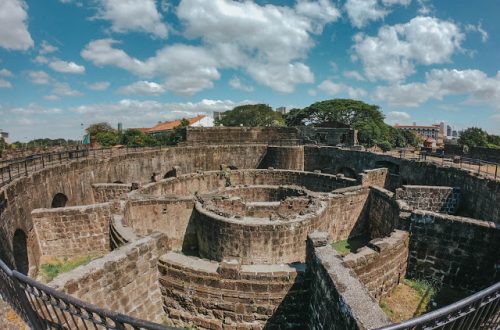
Sabtang Island, Batanes: Top 6 Places to Visit for a Day Tour
As we slowly approached Sabtang island under the gray skies, the morning sun peaked a little casting a warm gentle glow on the ocean and the hills from afar. My eyes were glued to the island clueless about the marvelous surprise that we were about to witness. I spotted a movement in the waters in my peripheral and thought, “that’s a flying fish, maybe,” not until it leaped gracefully out of the water leaving a few of us who first saw it in awe. “Dolphins, dolphins!” I exclaimed. A pod of dolphins appeared beside our faluwa with their playful antics bringing most of us passengers to the edge. It was such a spectacular scene that left us with a renewed sense of anticipation for our Sabtang island day tour.



About Sabtang Island
Sabtang Island is one of Batanes’s three inhabited islands, nestled in the southernmost part of the province. Renowned for its stunning landscapes and awe-inspiring vistas, it stands out as a haven of natural beauty. Moreover, Sabtang Island boasts the distinction of housing the most impeccably preserved villages and cultures among the inhabited islands in the region.
Pre-Sabtang Island Tour

At 5:30 AM, we gathered our essentials, eager to embark for our Sabtang Island trip. Our tour guide, Sir Paul Alcantara of Naidi Hills Tour Services picked us up. The drive to the Port of Ivana, where our adventure would truly begin, was a short 30-minute journey through winding roads that offered glimpses of Batan Island’s rugged beauty.


There are only two trips everyday from the port of Ivana in Batan island to Sabtang island: the 7:00 AM and the 10:00 AM trip. This sea travel may take 30 to 45 minutes depending on the waves. The last trip from Sabtang island, on the other hand, is at around 11:30 AM to 12:00 NN. Hence, Sabtang Island tours, especially day trips, are really time bound.
Places to Visit in Sabtang Island
For a memorable day trip, you’ll have the chance to explore a selection of four to six spots on Sabtang Island, providing you with a delightful taste of its unique charm. However, if you desire a more immersive experience at each attraction, consider extending your adventure to a two-day expedition. In either case, the following list highlights the must-visit destinations on Sabtang Island that should be an integral part of your itinerary:
Morong Beach, Ahaw Natural Rock Formation & Nakabuang Cave

This picturesque strip of beach with creamy-white, grainy sand at Brgy. Malakdang is one of the popular sites in Sabtang island. The stunning coastline features a panoramic view of the grass-covered hills and a shore that opens up to the vastness of West Philippine Sea. It’s also where you can find Ahaw Natural Rock formation considered as an iconic landmark not just in the island but also in Batanes. It’s a unique geological feature formed by limestone and stones, and its distinctive shape adds to the island’s charm.

Just behind the Ahaw Natural Rock Formation, you’ll discover Nakabuang Cave. While it’s relatively small compared to some other caves in the region, it’s an interesting spot to explore. The cave’s entrance is easily accessible from the beach, making it a convenient stop for curious travelers.
Savidug Village


Savidug Village embodies the essence of Ivatan culture, not just in its iconic stone houses but also in the enduring traditions upheld by its people.
As you wander through Savidug’s tranquil, narrow streets, your observant eyes will discern the subtle nuances in the architecture of these stone houses. You’ll encounter cubical structures crowned with four-angled thatched cogon roofs, locally known as “Maytuab,” and elongated rectangular dwellings adorned with two-angled cogon roofs, referred to as “Sinadumparan.”



A detail worth noting is that few of these stone houses boast balconies in their backyard areas. Our guide informed us that these balconies symbolize the prosperity of the Ivatan homeowners, adding yet another layer of intrigue to Savidug’s rich cultural tapestry.
Chamantad-Tinyan (Tiñan) Viewpoint

Sabtang Island also has its rolling hills but with a unique charm and perspective. It features high rise limestone cliffs and a lovely cove below adorned with a pristine white beach that meets the turquoise shallow waters of a reef break. While the hills are cloaked with short grass, you’d also notice that it is dotted with Vuyavuy palm trees, Philippines’ own version of date palms. Ivatans use these palm trees to create vakul, distinctive headgear, especially for women.


Prior to a walk into the viewpoint’s trails, you’ll find a line of souvenir shops around its concrete steps. These quaint stalls showcase local goods, each a piece of the island’s unique culture. The friendly vendors offer handmade crafts, intricately woven textiles, and even a taste of the local wine crafted from Arius, a testament to the island’s rich traditions and flavors.
Chavayan Village



Located in the southern reaches of the island is yet another Ivatan village, renowned as Batanes’ ultimate haven of tranquility. Chavayan Village is celebrated for its unadulterated simplicity, a realm where the pace of life remains unhurried, untethered from the digital age—no internet, no network signal.

In our quest for a deeper cultural connection, we opted to rent traditional Ivatan costumes from the Sabtang Weavers Association, allowing us to immerse ourselves fully in the rich heritage of this idyllic village.
At the entrance to Chavayan Village, is a modest hut that serves as a gateway to exploring the traditional Ivatan costume and handicrafts. This is the home of the Sabtang Weavers Association, where you can not only discover the intricacies of Ivatan attire like Vakul and Kanayi but also witness the artistry and craftsmanship that goes into creating these culturally rich garments and baskets.




The other side of the village indicates a beautiful conclusion to the walking tour. In here you’ll find the Chavayan beach, a rustic, Ivatan stone abode and a chapel built through their cooperative tradition (bayanihan) called Yaru.

Sabtang Lighthouse
Sabtang Lighthouse stands as the sole beacon on Sabtang Island. It stands tall and mighty over a cliff with crashing waves below. This majestic structure greets visitors with its commanding presence, whether they are arriving on the island or bidding it farewell. We took our time exploring the traditional villages and viewpoint that we ran out of time for others. Our encounter with the Sabtang Lighthouse was a fleeting one, as we paused to admire it while awaiting our faluwa at San Vicente port.

San Vicente Ferrer Church
The church’s history traces back to a modest chapel the Dominicans constructed in 1785. Since its humble beginnings, the chapel has weathered numerous trials. It experienced a period of abandonment when Chieftain Aman Dangat lead a revolution that forced the people to relocate to Ivana in 1891. Additionally, a powerful typhoon in 1956 inflicted damage upon its belfry, yet the church stands as a resilient testament to the enduring spirit of Sabtang Island.
Check out this detailed Batanes Travel guide to find out more about the places that you must see in this province!
Batanes Tour Rates 2023
We booked all our tours in Batanes at Naidi Hills Tour Services. Take note that they do not have a standard rate for a tour (i.e. North Batan, South Batan, etc). It is always dependent on the number of guests. Below are their standard Batanes Tour Rates for 4 days and 3 nights:
1 person – ₱11,500
2 persons – ₱6,800 per person
3 persons – ₱7,500 per person
4 persons – ₱5,999 per person
5 persons – ₱5,500 per person

These rates include the following:
- North Batan Tour
- South Batan Tour
- Sabtang Island Tour
- Accredited Tour Guide
- Lunch during tours
- Airport Transfers
- All Land Transfers
- Round trip Boat Transfers
- Port Fees
- Registration Fees
- Entrance Fees
- Environmental Fee
- Municipal Fees
- All other Government Fees
What to Remember Before your Sabtang Island Day Tour
- The LGU Tourism Office strictly prohibits DIY tours in the province ever since they reopened during the pandemic. Tourism officers or staff usually welcome the visitors by the airport’s arrival gate and would know if they have booked from DOT accredited tour operators or not. If it’s the latter, they would then assist the tourist in booking.
- Take note that the sea travel may be bumpy as the waters you’ll cross from Batan to Sabtang island is where the West Philippine Sea and Pacific Ocean’s currents meet. If you usually get seasick, might as well pop a pill before the trip.
- If you decide to bring and fly your drones, please coordinate with your tour guides first. Prior to all your tours, make sure that you’ll secure a DENR permit first amounting to Php 1,000.00 (as of September 2023). Take note that the Drone Permit from Batan Island is different from Sabtang Island.
- Wear comfortable footwear. You’ll be walking a lot in this tour.
- Use sun protection. Wear sunscreen or bring hat or umbrella with you especially if it’s a sunny day. Umbrellas may be of use as well just in case the weather unexpectedly changes.
- Bring drinking water in reusable bottle.
- Bring cash. Most establishments only accept cash basis transactions.

Explore Batanes
Explore more of Northern Luzon, Philippines:
- North Luzon Loop Road Trip Travel Guide 2023
- La Union’s Tangadan Falls DIY Travel Guide 2023
- Landingan Viewpoint, Nagtipunan, Quirino Province DIY Travel Guide 2023
- Top Places to Visit in Sagada, Mountain Province
- ISABELA PROVINCE TRAVEL GUIDE 2023
- 2023 DIY ILOCOS NORTE TRAVEL GUIDE





2 Comments
Tin Panes
Hello, loved your blog about sabtang. Just wanna ask if how long did you stay in the island? and about the tour package rate, that does include accommodation? tia😊
Anne Elizabeth Gumiran
Hello, Tin! Thank you for reading and appreciating my Sabtang island tour blog 🙂 We only stayed for a day as the gale warning was highly unpredictable during our stay and we wouldn’t wanna risk getting stranded. The tour services where we booked our Batanes trip could also arrange tours including the accommodation. It’s mentioned on this blog and we highly recommend them 🙂